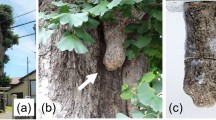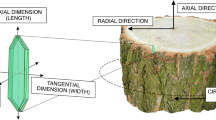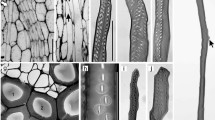Abstract
The chi-chi of Ginkgo biloba L. are cylindrical woody structures that grow downwards from the branches and trunks of old trees, eventually entering the soil where they give rise to adventitious shoots and roots. Examination of segments of young chi-chi taken from a mature ginkgo tree revealed an internal woody portion with irregular growth rings of tracheid-containing secondary xylem covered by a vascular cambium and bark. The cambium was composed of both fusiform cells and parenchymatous ray cells. Near the tip of the chi-chi, these two types of cambial cells had orientations ranging between axial, radial and circumferential with respect to the cylindrical form of the chi-chi. The xylem rays and tracheids that derived from the cambium showed correspondingly variable orientations. Towards the base of the chi-chi, the fusiform cells and young tracheids were aligned parallel to the axis, indicating that the orientation of the cambial cells in basal regions of the chi-chi gradually became normalised as the tip of the chi-chi extended forwards. Nevertheless, in such basal sites, tracheids near the centre of the chi-chi showed variable orientations in accordance with their mode of formation during the early stages of chi-chi development. The initiation of a chi-chi is proposed to derive from a localised hyperactivity of vascular cambial-cell production in the supporting stem. The chi-chi elongates by tip growth, but it does so in a manner different from organ growth driven by an apical meristem. It is suggested that the chi-chi of Ginkgo is an “evolutionary experiment” that makes use of the vascular cambium, not only for its widening growth but also for its elongation.













Similar content being viewed by others
References
Altamura MM (1996) Root histogenesis in herbaceous and woody explants cultured in vitro. A critical review. Agronomie 16:589–602
Ayadi R, Tremouillaux-Guiller J (2003) Root formation from transgenic calli of Ginkgo biloba. Tree Physiol 23:713–718
Baluška F, Volkmann D, Barlow PW (1999) Hormone-cytoskeleton interactions in plant cells. In: Hookyaas PJJ, Hall MA, Libbenga KR (eds) Biochemistry and molecular biology of plant hormones. Elsevier Science, Amsterdam, pp 363–390
Baluška F, Salaj J, Mathur J, Braun M, Jasper F, Šamaj J, Chua N-H, Barlow PW, Volkmann D (2000) Root hair formation: F-actin-dependent tip growth is initiated by local assembly of profilin-supported F-actin meshworks accumulated within expansin-enriched bulges. Dev Biol 227:618–632
Barlow P (2005) From cambium to early cell differentiation within the secondary vascular system. In: Holbrook NM, Zwieniecki MA (eds) Vascular transport in plants. Elsevier Academic Press, Amsterdam, pp 279–306
Barlow PW, Brain P, Powers SJ (2002) Estimation of directional division frequencies in vascular cambium and in marginal meristematic cells of plants. Cell Prolif 35:49–68
Barlow PW, Lück HB, Lück J (2004a) Pathways towards the evolution of a quiescent centre in roots. Biologia 59(Suppl 13):21–32
Barlow PW, Volkmann D, Baluška F (2004b) Polarity in roots. In: Lindsey K (ed) Polarity in plants. Blackwell Publishing, Oxford, pp 192–241
Carlson MC (1938) The origin of nodal adventitious roots in Salix cordata. Am J Bot 25:721–725
Casero PJ, Casimero I, Lloret PG (1995) Lateral root initiation by asymmetrical transverse divisions of pericycle cells in four plant species: Raphanus sativus, Helianthus annuus, Zea mays, and Daucus carota. Protoplasma 188:49–58
Chaffey N, Barlow PW (2000) Actin in the secondary vascular system of woody plants. In: Staiger CJ, Baluška F, Volkmann D, Barlow PW (eds) Actin: a dynamic framework for multiple plant cell functions. Kluwer Academic, Dordrecht, pp 587–600
Clowes FAL (1961) Apical meristems. Blackwells, Oxford
Dallimore W, Jackson AB (1948) A handbook of Coniferæ including Ginkgoaceae, 3rd edn. Arnold, London
Del Tredici P (1992) The Ginkgos of Tian Mu Shan. Conserv Biol 6:202–209
Del Tredici P (1993) Ginkgo chichi in nature, legend and cultivation. Int Bonsai 1993/no 4:20–25
Fink S (1999) Pathological and regenerative plant anatomy. Borntraeger, Berlin
Fujii K (1895) On the nature and origin of so-called “chichi” (nipple) of Ginkgo biloba, L. Bot Mag (Tokyo) 9:444–450
Gersani M (1987) Vessel differentiation along different tissue polarities. Physiol Plant 70:516–522
Gersani M, Sachs T (1990) Perception of gravity expressed by vascular differentiation. Plant Cell Environ 13:495–498
Groom P, Wilson SE (1925) On the pneumatophores of paludal species of Amoora, Carapa, and Heritiera. Ann Bot 39:9–24
Handa M, Iizuka Y, Fujiwara N (1997) Ginkgo landscapes. In: Hori T, Ridge RW, Tuleke W, Del Tredici P, Trémouillaux-Guiller J, Tobe H (eds) Ginkgo biloba. A global treasure. From biology to medicine. Springer, Tokyo, pp 259–283
Heaman JC, Owens JN (1972) Callus formation and root initiation in stem cuttings of Douglas-fir (Pseudotsuga menziesii (Mirb.) Franco). Can J Forest Res 2:121–134
Hejnowicz Z, Kurczyńska EU (1987) Occurrence of circular vessels above axillary buds in stems of woody plants. Acta Soc Bot Polon 56:415–419
Hellgren JM, Puech L, Barlow P, Fink S, Mellerowicz EJ, Sundberg B (2003) Auxin and cambial growth rate in poplar. Sylvestria 268:95–105
Jensen WA (1962) Botanical histochemistry. WH Freeman, San Francisco
Kato M, Imaichi R (1997) Morphological diversity and evolution of vegetative organs in Pteridophytes. In: Iwatsuki K, Raven PH (eds) Evolution and diversification of land plants. Springer, Tokyo, pp 27–43
Kerk N, Feldman LJ (1995) A biochemical model for the initiation and maintenance of the quiescent center: implications for organization of root meristems. Development 121:2825–2833
Kirschner H, Sachs T, Fahn A (1971) Secondary xylem reorientation as a special case of vascular tissue differentiation. Israel J Bot 20:184–198
Krause C, Eckstein D (1994) Dendrochronology of roots. Dendrochronologia 11:9–23
Kurczyńska EU, Hejnowicz Z (1991) Differentiation of circular vessels in isolated segments of Fraxinus excelsior. Physiol Plant 83:275–280
Kurczyńska EU, Hejnowicz Z (2003) Perception of gravity expressed by production of cambial callus in ash (Fraxinus excelsior L.) internodes. Acta Soc Bot Polon 72:207–211
Li Zhengli, Lin Jinxing (1991) Wood anatomy of the stalactite-like branches of ginkgo. Int Assoc Wood Anatomists Bull (New Series) 12:251–255
Lovell PH, White J (1986) Anatomical changes during adventitious root formation. In: Jackson MB (ed) New root formation in plants and cuttings. M Nijhoff Publishers, Dordrecht, pp 111–140
Lu P, Jernstedt JA (1996) Rhizophore and root development in Selaginella martensii: meristem transitions and identity. Int J Plant Sci 157:180–194
Mancuso S, Barlow PW, Volkmann D, Baluška F (2006) Actin turnover-mediated gravity response in maize root apices. Plant Signal Behav 1(2):52–58
Menezes NL de (2006) Rhizophores in Rhizophora mangle L.: an alternative interpretation of so-called “aerial roots”. Anais Acad Bras Ciênc 78:213–226
Montain CR, Haissig BE, Curtis JD (1983) Differentiation of adventitious root primordia in callus of Pinus banksiana seedling cuttings. Can J Forest Res 13:195–200
Romberger JA, Hejnowicz Z, Hill JF (1993) Plant structure: function and development. Springer, Berlin Heidelberg New York
Sachs T, Cohen D (1982) Circular vessels and the control of vascular differentiation in plants. Differentiation 21:22–26
Satoo S (1956) Anatomical studies on the rooting of cuttings in coniferous species (in Japanese with long English summary). Bull Tokyo Univ Forests 51:109–158
Schrader J, Baba K, May ST, Palme K, Bennett M, Bhalerao RP, Sandberg G (2003) Polar auxin transport in the wood-forming tissues of hybrid aspen is under simultaneous control of developmental and environmental signals. Proc Natl Acad Sci USA 100:10096–10101
Senata W (1990/1991) Czi-czi i inne naroś na miłorzębach (Ginkgo biloba L.) w Polsce. (Chi-chi and other burs on maidenhair trees (Ginkgo biloba L.) in Poland) (in Polish). Rocznik Dendrologiczny 39:117–128
Snigirevskaya NS (1994) A unique mode of the natural propagation of Ginkgo biloba L.—the key to the problem of its “survival”. Acta Paleobot 34:215–223
Srivastava LM (1963) Cambium and vascular development of Ginkgo biloba. J Arnold Arboretum 44:165–188
Takami W (1955) Observations on Ginkgo biloba L (in Japanese). J Jap Bot 30:340–345
Voronin NS (1964) Evolution of primary structure of plant roots. Kaluga State Pedagogical Institute, Sci Trans 13:3–179 (in Russan)
Waller F, Riemann M, Nick P (2002) A role for actin-driven secretion in auxin-induced growth. Protoplasma 219:72–81
Acknowledgments
Thanks are due to Professor Bogdan Zemanek, director of the Botanical Garden, Jagiellonian University of Krakow, Poland, for permitting us to take samples of chi-chi, and to Professor Z. Hejnowicz for his helpful comments at an early stage of this work. PWB thanks the Silesian University, Katowice, for financial support during the course of this study, and also Mr. Timothy Colborn, who prepared the plates.
Author information
Authors and Affiliations
Corresponding author
Rights and permissions
About this article
Cite this article
Barlow, P.W., Kurczyńska, E.U. The anatomy of the chi-chi of Ginkgo biloba suggests a mode of elongation growth that is an alternative to growth driven by an apical meristem. J Plant Res 120, 269–280 (2007). https://doi.org/10.1007/s10265-006-0050-3
Received:
Accepted:
Published:
Issue Date:
DOI: https://doi.org/10.1007/s10265-006-0050-3




